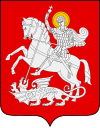Defense Forces of Georgia
The Defense Forces of Georgia (Georgian: საქართველოს თავდაცვის ძალები, translit.: sakartvelos tavdatsvis dzalebi), or Georgian Defense Forces, known as the Georgian Armed Forces (Georgian: საქართველოს შეიარაღებული ძალები, translit.: sakartvelos sheiaraghebuli dzalebi) until December 2018, are the combined military forces of Georgia, tasked with the defense of the nation’s independence, sovereignty, and territorial integrity. They consist of the Land Force, Air Force, National Guard, and Special Operations Forces. The Defense Forces are under overall leadership of the Minister of Defense of Georgia and directly headed by the Chief of Defense Forces.
| Defense Forces of Georgia | |
|---|---|
| საქართველოს თავდაცვის ძალები | |
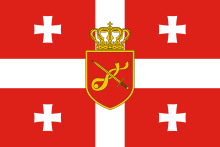 Flag of the Georgian Defense Forces | |
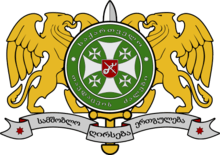 | |
| Founded | 30 April 1991 |
| Current form | December 2018 |
| Service branches | |
| Headquarters | Tbilisi, Georgia |
| Website | mod |
| Leadership | |
| Commander-in-chief | President Salome Zurabishvili |
| Minister of Defence | Irakli Garibashvili |
| Chief of Defense Forces | Lt Gen Vladimer Chachibaia[1][2] |
| Manpower | |
| Military age | 18-30 years old |
| Conscription | 18 years of age, 12 months |
| Available for military service | 2,038,736, age 18-35 (2011 est.) |
| Fit for military service | 827,281, age 18-35 (2011 est.) |
| Reaching military age annually | 56,965 (2011 est.) |
| Active personnel | 37,000 (2017)[3] |
| Deployed personnel | Afghanistan, Central African Republic, Mali |
| Expenditures | |
| Budget | 880 million GEL (2020)[4] 290,000,000 USD (2020) |
| Percent of GDP | 1.81% |
| Industry | |
| Domestic suppliers | Tbilisi Aircraft Manufacturing Scientific Technical Center Delta Tbilisi Tank Factory |
| Foreign suppliers | Former: |
| Related articles | |
| History | Military history of Georgia List of wars involving Georgia List of equipment of the Defense Forces of Georgia |
| Ranks | Georgian military ranks |
The first regular military was established in the first Georgian Republic in 1918 and was in existence until after the republic's overthrow by the invading Soviet Russian forces in 1921. The modern Georgian military were founded in accordance with the government decree of 24 April 1991. 30 April, the day when the first conscripts were called up for military service in 1991, has been celebrated as the day of the Georgian military forces.[5]
The Georgian military have fought in the civil war and separatist conflicts in the 1990s and the Russo-Georgian War of 2008 as well as major international military missions such as in Iraq and Afghanistan. Georgia was one of the first former Soviet republics to join the NATO Partnership for Peace program in 1994 and Individual Partnership Action Plan (IPAP) in 2004 and has sought to bring its military in line with the NATO standards.
History
The Georgia Train and Equip Program (GTEP) training was conducted using U.S. Special Operations Forces and U.S. Marine Corps forces from May 2002 to May 2004. During this time approximately 2,600 Georgian soldiers, including a headquarters staff element and 5 tactical units, received training. Another assistance program, the Georgia Security and Stability Operations Program (Georgia SSOP), was launched in January 2005 as a continuation of the (GTEP) of 2002-2004. Georgian contingents were involved in the Kosovo Force and continue to participate in the operations in Iraq and Afghanistan.
The DFG have been extensively reformed in the recent years to meet Georgia’s aspirations to join NATO and for better response to the existing challenges such as the ongoing tensions in the unresolved separatist conflict areas in Abkhazia and South Ossetia as well as to the threats of global terrorism. Georgia also views a large-scale foreign invasion and the spillover of conflicts from Russia’s North Caucasus as the worst potential near- and long-term scenarios, respectively.[6]
On August 8, 2008 the Georgian military conducted an operation in Georgia's breakaway region South Ossetia (see 2008 South Ossetia War). The operation led to an armed conflict with forces from the Russian Federation and resulted in the defeat and expulsion of Georgian forces from South Ossetia and Abkhazia. Following the military operations, Russia recognized independence of the regions, declared a decade ago.
The military budget of Georgia increased more than 50 times over the period from 2002 (US$18 mln.) to 2007 (US$780 mln.), reaching over 7% of Georgia's GDP. The military budget was then doubled to the end of 2008 and currently since February 2009, counts 660 mln lari (US$366 mln.)
21st century
In August 2008, following a series of fierce clashes in South Ossetia, Georgia attempted to re-take the separatist territory by force. In the resulting military conflict with Russia, Georgia was driven out of South Ossetia and Abkhazia, and lost parts of its military capabilities. According to Defence Minister Davit Kezerashvili, Georgia lost $400 million of material worth.[7] Out of its original 200 T-72 tanks, some 55 were abandoned and captured by the enemy and 10 destroyed in combat. Much of the captured equipment that was not subsequently destroyed got transferred to Russia or given to the separatists. Parts of Georgia's relatively modern artillery and anti-aircraft units were captured and later destroyed. Russian forces sank four Georgian naval vessels in the port of Poti, a coast guard gunboat in a naval skirmish, and hauled away nine rigid-hull inflatable boats. The Georgian Air Force lost two L-29 jet trainers, one AN-2 airplane, and four helicopters, all destroyed on the ground. Despite these mostly non combat losses, President Mikheil Saakashvili claimed that Georgia had lost less than 5% of its military hardware, contradicting figures from the Georgian military itself.[8]
Reconstruction
Georgia immediately began a process of re-armament after the war. The conflict was immediately followed by a very quick replenishment program of the gaps in the single GAF arms components with an additional massive re-equipment and modernization program. Two Georgian naval vessels sunk in Poti were raised and returned to service, although one had to undergo repairs.[9] The Georgian Navy's remaining operational naval units were merged into the Georgian Coast Guard, which received training in search and seizure tactics from the United States. Ukraine delivered munitions and artillery systems to Georgia in September 2008,[10] and later supplied Georgia with 25 T-72 tanks, three BTR-80 armored personnel carriers, sixty portable air defence missiles, munitions for rocket launchers, and anti-tank guided missiles.[11] Ukraine continued to supply shipments of arms to Georgia, and announced that it would only stop if the United Nations Security Council imposed an arms embargo. Israel supplied Georgia with firearms after the war. The United States also delivered some amounts of arms and light military equipment to Georgia after the war, and trained Georgian personnel.[12] Israel sold Georgia numerous unmanned aerial vehicles, and supplied Georgia with two helicopters. The United States also trained Georgian soldiers to be deployed in Afghanistan. Georgia also rebuilt its damaged military bases. In August 2010, Georgia was reported to be spending 30 times more on its military budget than on economic development.[13] By late 2010 the Georgian military had reached a strength greater than pre-war levels and, after completing the reforms, decisively reduced military spending.[14] Beginning in 2010, Georgia started to produce its own line of armoured fighting vehicles, small arms, artillery systems, and unmanned aerial vehicles.
2014 NATO summit in Wales

The most recent major reforms started in late 2013 and have been expanded by the NATO Wales summit resolution of 2014. NATO officially announced the complete support of the country's efforts in establishing the efficient military force that is required to defend the country against any regional threats and agreed on delivering high end sophisticated defense capabilities and boosting the overall quality of the GAF. The package also includes a group of NATO experts monitoring the process in order to control and ensure its successful implementation for the given time period. Further a large training center for joint military drills will be constructed. NATO did not state that it would directly arm the GAF but fully assist in acquiring requested military hardware and that it would lift the general arms embargo on Georgia that was in effect since 2008. After the last major conflict with Russia, Georgia repeatedly was denied the delivery of modern anti-air and anti-tank weapons and other heavy equipment despite heavy shortage on said weapons and numerous demands and harsh criticism from both the former and current ruling parties.
Almost immediately after the summit US defense secretary Chuck Hagel announced during his visit to Georgia that the US will start providing long requested UH-60 Blackhawk helicopters which is an arrangement reportedly outside the NATO package. Russia reacted very critical to the plan of building an international training center in Georgia claiming it would bring instability to the region. The statement was denied by NATO reminding that Georgia is a PFP member and already provides similar capabilities such as an alpine warfare school for NATO and partner nations.[15][16][17][18][19][20][21]
Alternative to MAP
Despite knowing that there would not be any newcomers announced during the Wales summit, the Georgian government was confident that their country would at least receive the Membership Action Plan, which is the primary precondition for aspirant nations to become NATO member. Instead of the MAP Georgia was offered an alternative route which got accepted by the country's officials yet was met with very mixed reception. The new level of cooperation brings Georgia onto the list of special NATO partners together with Sweden and four other countries.
Organization
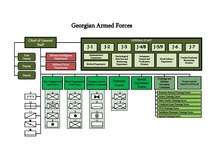
The overall strength of the DFG in 2013 was 43,475, including 37,825 active duty personnel, 1,940 civilians in the education sphere, 533 in health insurance, and 3,177 for supply duties.[22] The Georgian legislation (17 December 2010) had established that the strength of the armed forces should not exceed 37,000 up to the year 2011. Recruitment and size have been increased since 2008. Limitations do not extend to the state of war, military reserve and temporary staff of the Defence Ministry of Georgia.[23] Currently there are 37,000 active personnel. The number is to be maintained in 2017 as well.[24]
Structure
The Defense Forces of Georgia consist of four branches: Land Forces, Air Force, National Guard, and Special Operations Forces.[25]
The overall command is exercised by the Chief of Defense Forces, who is aided by the General Staff of the Defense Forces. The Defense Forces are further organized into several structural units:[25]
- Eastern Command
- Western Command
- Air and Air Defense Command
- Special Operations Forces
- Military Training and Education Command
- Army Logistics Command
- National Guard
- Military Police
- Department of Military Intelligence
In wartime, several other bodies fall under the control of the Defense Forces additionally. These are:[25]
- Border Police of Georgia, a subordinate agency of the Ministry of Internal Affairs of Georgia
- Department of Special Operations - Public Security Forces, a subunit of the Ministry of Internal Affairs of Georgia
- Department for Protection of Strategic Pipelines, a subunit of the Ministry of Internal Affairs of Georgia
- Department for Protection of Strategic Infrastructure, a subunit of the Ministry of Internal Affairs of Georgia
- National Defense Academy of Georgia, a legal entity under the Ministry of Defense
- Military Hospital of the Ministry of Defense
- Cybersecurity Bureau, a legal entity under the Ministry of Defense
- Data Exchange Agency, a legal entity under the Ministry of Justice of Georgia.
The Eastern Command and its Western counterpart are two main regional operational groupings, respectively, for eastern and western Georgia. They were created in the 2010s in order to have two autonomous territorial commands, with their own military staffs, logistical and administrative resources.
The Eastern Command consists of:
- 1st Infantry Brigade
- 4th Mechanized Infantry Brigade
- 5th Artillery Brigade
- Special Operations Battalion East
- Combat Engineer Battalion
- Separate Communications Company
The Western Command consists of:
- 2nd Infantry Brigade
- 3rd Infantry Brigade
- 6th Artillery Brigade
- Special Operations Battalion West
- Combat Engineer Battalion
- Medical Company
- Separate Communications Company
Branches
The Land Forces form the largest component of the DFG responsible for providing land defence against any threat to the nation’s sovereignty and territorial integrity, supporting Border Police in border protection and civil authorities in counter-terrorist operations as well as providing units for NATO-led and coalition operations abroad. They are organized into infantry brigades, artillery and other supporting capacities operating at a battalion level.[26]
The Special Operations Forces are responsible for conducting special reconnaissance, unconventional warfare and counter-terrorism operations. The Georgian National Guard organizes and trains reservists in the peacetime and mobilizes them during a crisis or wartime.[26]
Ground arms
The structure of the Georgian Land Forces is based on brigade and battalion-sized military units. The main force consists of four infantry, two artillery, one air defence brigades and several independent battalions. Georgian brigades have a total manpower of 3,000 each excluding non-combat personnel.[27] The overall strength of the land forces in 2013 was 37,825 (excluding active reserve), from which 21 were high-ranking officers, 6,166 officers and sergeants, 28,477 corporals and privates, 125 cadets and 388 civilians.[28] Accordingly, to NATO structures and higher standards reached the brigades were downsized to optimal as well as the 5th brigade disbanded, also to increase the percentage of spending on arms acquirement, which was previously 2%, to 6% of the military budget. The goal is to reach at least 15% until 2020. The ground forces are equipped with a variety of weapons and vehicles. Special forces operate independently under MOD direction.
The Georgian Land Force consists of following primary combat formations (incomplete):[29]
Force composition
.jpg)
.jpg)

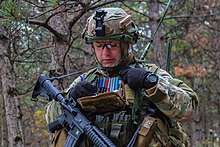
- HQ, Land Forces Command (Tbilisi)[30]
- Central Command Point
.png)
- 1st Infantry Brigade (Tbilisi)
- 11th Light Infantry Battalion
- 12th Light Infantry Battalion - NRF
- 13th Light Infantry Battalion
- 4th Mechanized Infantry Brigade (Vaziani)
- 41st Mechanized Infantry Battalion
- 42nd Mechanized Infantry Battalion
- 43rd Mechanized Infantry Battalion
- 5th Artillery Brigade (Vaziani)
- Special Operations Battalion East
- Combat Engineer Battalion
- 1st Infantry Brigade (Tbilisi)
.png)
- 2nd Infantry Brigade (Senaki)[31]
- 21st Light Infantry Battalion
- 22nd Light Infantry Battalion
- 23rd Light Infantry Battalion
- 3rd Infantry Brigade (The Mamelukes) (Kutaisi)
- 31st Light Infantry Battalion
- 32nd Light Infantry Battalion
- 33rd Light Infantry Battalion
- 6th Artillery Brigade (Khoni)
- Special Operations Battalion West
- Combat Engineer Battalion
- Medical Company
- Separate Communications Company
- 2nd Infantry Brigade (Senaki)[31]
Separate Elements
.png)
.png)
.png)
- Engineer Brigade
- Separate Reconnaissance Battalion (Kobuleti)
- Separate Medical Battalion (Saguramo)
- Separate Signal Battalion
- Separate Logistics Battalion
In 2011 the Georgian high command decided to divide its military forces into two main operational units; the Eastern and Western Operational Groups. The aim was to create two independently acting military districts which would consist of forces in accordance to the strategic value of their deployment areas yet being balanced in their type of equipment. In case of war each group will be able to coordinate its operations independently from high command, having its own logistical and administrative reserves.
Special Operations Forces
The Special Operations Forces of the Defence Forces of Georgia were established to conduct unconventional warfare and the full spectrum of special operation missions. They also serve in supporting capacity for regular military forces, primarily in the areas of education and training.
Georgian special forces became first active in 1999 as part of KFOR. Georgian commandos participated in the Iraq War from 2003 until the complete withdrawal of the Georgian contingent in 2008 due to an escalation of hostilities in South Ossetia. According to independent accounts, a number of Georgian operatives were also deployed prior in Afghanistan to aide US Special Forces in hunting down Taliban leaders. Georgian officials have stated that a group of servicemen were deployed in Afghanistan for medical purposes.
Army Air Section (former Air Force)
The Strategic Defence Review in 2007 described the Air Force consists of aviation and air defence assets and provides security to Georgia’s airspace.
The Georgian Air Force was merged into the Army in 2010, and was renamed the Army Air Section, undergoing massive reorganization and restructuring. The additional operative section of the Georgian Land Forces currently consists of an unknown amount of planes, transport helicopters, gunships and 3,000 personnel. The Georgian Air Force lost two helicopters and a number of transport and trainer aircraft on ground during the 2008 South Ossetia War,
Two major airfields are located near Tbilisi at Alekseevka and Marneuli.
Georgian Coast Guard (Former Naval Force)
In 2007 the Strategic Defence Review said the Georgian Navy protects Georgia’s territorial waters and contributes to the collective maritime defence in the Black Sea region.
The Georgian Navy was abolished in 2009 and was incorporated into the Coast Guard, which is not structurally part of the Defense Forces, but rather it is a subunit of the Border Guard of Georgia, which is under the control of Ministry of Internal Affairs of Georgia. The Coast Guard of Georgia is responsible for maintenance of the sovereignty of the country and for protection of internal territorial waters and economic zones. The headquarters and a principal Coast Guard base are located at the Black Sea port of Poti.
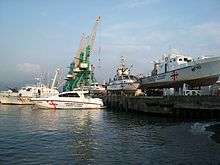
The other, smaller Coast Guard base is in Batumi. Besides the naval force, the navy also includes a Special Counter-terrorist Detachment force. Georgia is also one of the founding members and a participant of the Black Sea Naval Co-operation Task Group. Before the war with Russia, the Georgian navy had 19 naval vessels. Four of them were sunk during the conflict, and nine rigid-hull inflatables were captured by Russia. The Georgians raised and returned to service two of the sunken vessels, and partially replaced their losses with Turkish-built patrol/fast attack boats. Their heaviest armaments are 25−30mm cannons. However, no Georgian navy vessels are armed with ship-to-ship missiles.
National Guard of Georgia
The National Guard of Georgia was established on December 20, 1990 and was manned mainly by volunteers. It represents the first Georgian armed formation, which became the base of the foundation for modern Defense Forces of Georgia. The Guard actively participated in the conflicts that occurred in Georgian territory (Samachablo, Abkhazia).
The National Guard used to consist of 20,554 personnel, but has now been reduced to 550. The main missions of the National Guard are:
- Support civil government in crisis situations (natural, technological, ecological);
- Register mobilization resources, study and deliver;
- Convene, select and man of citizens on the basis of the agreement, for the units, subunits and bases of the Defense Forces;
- Provide ceremonial activity support;
- Assisting in training the Reserve Forces.
Army Reserve and Territorial Defence Forces
The Army Reserve is a professional reserve force consisting of former regular army personnel only. Due to the amount of experience, the Reserve personnel would be set-in for replacement of losses in the ranks of regular formations and will if needed also operate in the vanguard of a combined mechanized group or an infantry assault.
The Territorial Defence Forces were established for immediate readiness of the population in crisis events, such as war. Its main goals would be the fortification and defence of all populated and strategically important areas as well as providing quick aid or security for evacuation operations in case of natural catastrophes.
Other than the active army reserve which consists of only ex military personnel, the Territorial Defence Forces are rather sparsely prepared for complex military operations. It instead provides more comfort for the regular forces in case of war. By acting as additional logistical arm and leaving the actual combat to them. With the land forces and reserve army engaged in direct action the Defence Force's most important task would be to construct trenches, bunkers and obstacles around strategically important areas and position themselves on systematically formed defensive lines. The number of conscripts does not exceed 140,000 and is reasonably large, as it is in the strategy's intention to use any possible geographical advantage over the enemy, when professionalism is compensated by that factor.
The TDF reservist is comparably poorly equipped for modern warfare. The number of combat, protection gear and supplies will be most likely limited in the event of war. The Territorial Defence Force consists of ordinary citizens of all occupations who undertake training in the basics of modern warfare. The weapons trained on are mainly of soviet origin and abandoned material used formerly by the regular land forces, including tanks. Such weapons are the AK series assault rifles and the RPG-7 rocket propelled launchers.
Commissioned officers
| Equivalent NATO code | OF-10 | OF-9 | OF-8 | OF-7 | OF-6 | OF-5 | OF-4 | OF-3 | OF-2 | OF-1 | OF(D) and student officer | |||||||||||||||||||||||||
|---|---|---|---|---|---|---|---|---|---|---|---|---|---|---|---|---|---|---|---|---|---|---|---|---|---|---|---|---|---|---|---|---|---|---|---|---|
(Edit) |
No equivalent |  |
 |
 |
 |
 |
 |
 |
 |
 |
 |
 |
No equivalent | |||||||||||||||||||||||
| General (გენერალი) |
Lieutenant General (გენერალ ლეიტენანტი) |
Major General (გენერალ მაიორი) |
Brigadier General (ბრიგადის გენერალი) |
Colonel (პოლკოვნიკი) |
Lieutenant Colonel (ლეიტენანტ პოლკოვნიკი) |
Major (მაიორი) |
Captain (კაპიტანი) |
Senior Lieutenant (უფროსი ლეიტენანტი) |
Lieutenant (ლეიტენანტი) |
Junior Lieutenant (უმცროსი ლეიტენანტი) | ||||||||||||||||||||||||||
(Edit) |
No equivalent |  |
 |
 |
 |
 |
 |
 |
 |
 |
 |
 |
Unknown | |||||||||||||||||||||||
| General (გენერალი) |
Lieutenant General (გენერალ ლეიტენანტი) |
Major General (გენერალ მაიორი) |
Brigadier General (ბრიგადის გენერალი) |
Colonel (პოლკოვნიკი) |
Lieutenant Colonel (ლეიტენანტ პოლკოვნიკი) |
Major (მაიორი) |
Captain (კაპიტანი) |
Senior Lieutenant (უფროსი ლეიტენანტი) |
Lieutenant (ლეიტენანტი) |
Junior Lieutenant (უმცროსი ლეიტენანტი) | ||||||||||||||||||||||||||
| Equivalent NATO code | OF-10 | OF-9 | OF-8 | OF-7 | OF-6 | OF-5 | OF-4 | OF-3 | OF-2 | OF-1 | OF(D) and student officer | |||||||||||||||||||||||||
International cooperation


The Defense Forces have been participating in peacekeeping missions (the Balkans, Persian Gulf) since 1999.
Units participating in peacekeeping missions are manned by professional soldiers, the duration of the mission is six months and participation is voluntary. The readiness assessment criteria are, as follows: health condition, physical fitness, professional skills and experience.
Peacekeeping missions

About 200 Georgian troops were deployed in the Kosovo (KFOR) in 1999–2008, 70 were deployed in Iraq (OIF) in 2003 and 50 in Afghanistan in 2004 (ISAF). From 2004 in Iraq were 300 Georgian troops. From 2005 approximately 850 troops were serving under Coalition Command (OIF and UNAMI). On July 2007 Georgia sent an extra 1,400 troops to Iraq; that brought the total number of troops in Iraq to 2,000. About 300 of these troops were assigned to Taskforce Petro and stationed at COP Cleary outside the town of Wahida near Salman Pak, Iraq. On August 8, 2008 Georgia announced it will withdraw 1,000 troops from Iraq due to rising hostilities with Russia. Their preparedness and training skills are evaluated on highest level by international experts. The entire Iraq contingent has been airlifted back to Georgia.
Hence, owing to participation in international peacekeeping missions the military members are able to obtain practical experience and to show readiness to cooperate with NATO and with other partner countries' forces.
Currently there are more than 1,570 Georgian combat troops deployed in Helmand, Afghanistan where Georgia has thus far suffered 22 deaths and over a hundred injuries.[32][33] In September 2012, Georgia stated that it would continue its contributions in Afghanistan following the 2014 NATO withdrawal.[34]
In November 2012, Georgia had doubled the number of troops deployed to fight with Nato-led forces in Afghanistan to over 1,500. Georgia has 1,570 troops serving there, making the small Caucasus country of 4.5 million people the largest non-Nato contributor to the Afghanistan mission.[35]
Since 2014 Georgia has contributed 140 troops to the EUFOR RCA peacekeeping mission in the Central African Republic.
Commanders
The Chief of General Staff is the highest-ranking officer in the military, heading the General Staff and being the ex officio Deputy Chief of the Defense Forces, who is the commander of the Defense Forces, being appointed by the Minister of Defense. The senior enlisted advisor of the Georigan military is the Sergeant Major of the Georgian Defense Forces (Georgian: საქართველოს შეიარაღებული ძალების სერჟანტი მაიორი, translit.: sakartvelos sheiaraghebuli dzalebis serzhant'i maiori), currently Sergeant Major Koba Tsirekidze (appointed on 11 April 2016).[36]
Military industry

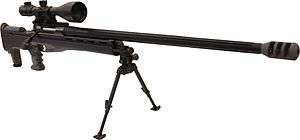
.jpg)
Georgia has a long history of weapon production tracing back to ancient times. More recent developments however have their roots in the Soviet Union. In 1941 Georgia became one of the most important Soviet weapon manufacturing countries during the Second World War. It was responsible for providing the Soviet Army with all types of aircraft and ammunition. Tbilisi Aircraft Manufacturing's role didn't change after the war. Up until 1990 Georgia was producing various types of fighter aircraft, most notably the Su-25 since it was produced almost exclusively in Georgia, unmanned areal vehicles, missiles, satellite components and orbital satellites. The company lost most of its functionality and production capability when the Soviet Union dissolved, yet was not abandoned. In the late 1990s Georgia's JSC RMP and later the newly established Ministry of Defence section "Delta" started to work on the development of ballistic equipment using their own ingredients. The advanced research unit had successfully developed a variety of personal protection gear, such as bomb disposal suits and level I-IV body armour using classified mixtures of domestic resource. These projects never went beyond some prototypes, mainly due to poor attention and financing from the government.
With foreign support primarily from the United States since 2005, Georgia became able to start building a solid industrial base for the military. From 2001 to 2007, Delta experimented with unmanned aerial vehicles and modified parts for helicopters and Su-25 aircraft until it got involved in the modification of Georgia's T-72 tank fleet. In 2009-10, with enough experience and expertise and the assistance of designer Zviad Tsikolia, Delta created its first prototype of an armored personnel carrier, the Didgori. Early tests were highly successful so that its first production line started already in 2011. Two versions would initially serve in the armed forces in 2012, followed by different modifications from 2013 on. The Lazika is Delta's attempt to manufacture a suitable modular infantry fighting vehicle created for multiple tasks. While still under development, some Lazikas are already in active service. Delta considers the Lazika as one of the best vehicles of its class bearing armour technology similar to that of Israel. The remotely operated systems are locally produced as well. Due to "misdirected financing" and heavy interfering of former government officials, project Lazika was temporarily cancelled in late 2012, also due to "sabotage" and shortcomings in its armour research, but then later continued in early 2013 when a newly elected government took charge.
As of 2007 Georgia has been domestically producing uniforms for its military personnel. Early products were of poor quality, and such shortcomings were only corrected beginning in 2012. Since then only high quality fabrics are licensed for use. Other main production lines include various types of artillery systems such as MLRS, mortars and corresponding ammunition, anti-tank weapons and devices, full uniform sets for ceremonies and for all service branches, including boots, hats, assault vests, pouches, and backpacks. New kind of ballistic vests and helmets have been developed and produced for military service since 2013. The Georgian production uses techniques based on know-how from aerospace research whose methods differ slightly yet significantly from foreign ones. Among the first units to use these new items is the peacekeeping contingent currently stationed in the Central African Republic.
Bases
| Name | Location |
|---|---|
| Ministry of Defence Headquarters | Tbilisi |
| Vaziani Military Base | near Tbilisi |
| Krtsanisi Military Base | near Tbilisi |
| Akhalkalaki Military Base | Akhalkalaki |
| Alekseevka Airbase | near Tbilisi |
| Marneuli Airbase | Marneuli |
| Bolnisi Airbase | near Tbilisi |
| Gori Military Base | Gori |
| Senaki Military Base | Senaki |
| Poti naval base | Poti |
| Mukhrovani Military Base | Mukhrovani |
| Kutaisi Military Base | Kutaisi |
| Khelvachauri Military Base | Khelvachauri |
| Khoni Military Base | Khoni |
| Batumi naval base | Batumi |
See also
- Georgia and NATO
- Modern equipment of the Georgian Army
References
- "President appoints new Chief of General Staff of the Georgian Armed Forces". agenda.ge.
- "საქართველოს თავდაცვის სამინისტრო". mod.gov.ge.
- "Georgian Armed Forces capacity retained for 2017". Agenda.ge. 15 September 2016. Retrieved 10 January 2019.
- "Georgia's defense ministry spending 880 mln GEL in 2020". Civil Georgia. 13 December 2018. Retrieved 30 September 2019.
- "Georgia marks Armed Forces Day". Agenda.ge. 30 April 2018. Retrieved 10 January 2019.
- The Strategic Defense Review (2007), p. 77.
- "Archived copy" (PDF). Archived from the original (PDF) on 2011-09-03. Retrieved 2012-02-02.CS1 maint: archived copy as title (link)
- "WebCite query result". www.webcitation.org.
- "Tutte le dimensioni |IMG_0721 | Flickr – Condivisione di foto!". Flickr.com. Retrieved 2013-08-17.
- Archived May 23, 2012, at the Wayback Machine
- Archived January 20, 2010, at the Wayback Machine
- "U.S. Reviewing Military Aid to Georgia, Pledges to Prevent Russia From Creating 'Divide' in Europe". Fox News. December 7, 2011.
- "$400 mln on guns, $12 mln on economy: Saakashvili's spending plan". RT. 8 August 2010 – via YouTube.
- "Russian peacekeeper". Russian peacekeeper. Retrieved 2013-08-17.
- "Relations with Georgia". NATO.
- "U.S. to strengthen its military cooperation with Georgia". 12 September 2014.
- "NATO will not offer Georgia membership step, avoiding Russia clash". 25 June 2014 – via Reuters.
- "NATO chief details package to "bring Georgia closer" to Alliance". agenda.ge.
- "CBC News - U.S., Georgia strengthen defence ties over Russian aggression". www.cbc.ca.
- "Defying Russia, Georgia to host NATO training centre - minister". Reuters.
- Georgia, Civil. "Civil.Ge - NATO, Georgian FMs Hold Meeting". www.civil.ge.
- "Archived copy" (PDF). Archived from the original (PDF) on 2013-05-08. Retrieved 2013-08-17.CS1 maint: archived copy as title (link)
- (in Georgian) საქართველოს სამხედრო ძალების რაოდენობის დამტკიცების შესახებ. Parliament of Georgia. December 17, 2010. Accessed April 12, 2011
- "Georgian Armed Forces capacity retained for 2017". agenda.ge.
- "საქართველოს თავდაცვის შესახებ" [On Defense of Georgia]. Law No. 1030 of 31 October 2018 (in Georgian).
- The Strategic Defense Review (2007), p. 74.
- "Structure of Land Forces". Mod.gov.ge. Archived from the original on 2013-11-05. Retrieved 2013-08-17.
- "Вооружённые силы Грузии". milkavkaz.net. 2009-10-13. Retrieved 2013-08-17.
- "Georgian Ministry of Defence: Land Force". Mod.gov.ge. Archived from the original on 2014-03-23. Retrieved 2013-08-17.
- "საქართველოს თავდაცვის სამინისტრო" (PDF). www.mod.gov.ge.
- See also http://desantura.ru/veteran/521/
- Tenth Georgia Soldier Killed in Afghanistan Retrieved: September 1, 2011
- Seth Robson. "U.S. training a dual mission for Georgians". Stripes.com. Retrieved 2011-06-13.
- Georgia keeps helping Afghanistan - Armyrecognition.com, September 10, 2012
- "Georgia doubles number of troops in Afghanistan". Khaama Press (KP), Afghan Online Newspaper. November 28, 2012.
- https://ncolcoe.armylive.dodlive.mil/koba-tsirekidze/#:~:text=Sergeant%20Major%20Koba%20Tsirekidze%20was,Armed%20Forces%20as%20a%20corporal.
![]()
![]()
Further reading
- Denise Hammick, Country Briefing: Georgia On the Cusp, Jane's Defence Weekly, 2 January 2008
External links
| Wikimedia Commons has media related to Military of Georgia. |
- geo-army.ge, an information website
- Ministry of Defence of Georgia: The Strategic Defence Review 2007. mod.gov.ge. Accessed on May 7, 2008.
- GlobalSecurity.org on Georgia’s military
- Ministry of the defence of Georgia: Armed Forces of Georgia. Accessed on March 6, 2009.
- Military Heraldry of Georgian Armed Forces.
